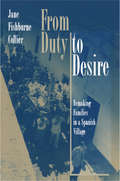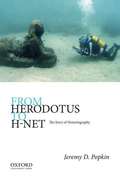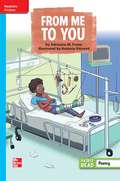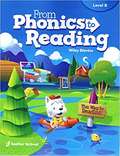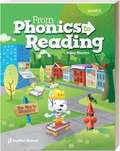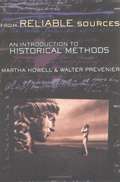- Table View
- List View
From Duty to Desire: Remaking Families in a Spanish Village
by Jane Fishburne CollierIn the 1980s, Jane Collier revisited a village in Andalusia, where she and others had conducted fieldwork twenty years earlier, to investigate changes in family relationships and to explore the larger question of the development of a "modern subjectivity" among the people. Whereas the villagers she met in the sixties stressed the importance of meeting social obligations, the people she interviewed more recently emphasized the need to think for oneself: status concerns in choosing a spouse had apparently been replaced by romantic love, patriarchal authority by partnership marriages, parental demands for obedience by hopes of earning children's affection, mourners' respect for the dead by personal expressions of grief. In each of these areas, the author detected a modern concern for "producing oneself," which emerged with changes in how villagers experienced social inequality. <P><P>Collier notes that when inheritance appeared to determine social status, villagers protected family reputations and properties by demonstrating concern for "what others might say." Once villagers began participating in the national job market, where individual achievement appeared to determine a worker's income, they focused on realizing their inner abilities and productive capacities. Sensitivity to one's feelings, thoughts, and aptitudes, along with "rational" assessments of the costs and benefits entailed in "choosing" how to use them, testified to a person's unceasing efforts to realize inner potentials. The author also traces shifts in the meaning of "tradition," suggesting that although "modern" people cannot "be" traditional, they must have traditions in order to produce themselves.
From Fright to Might
by Mt. San Antonio College Department of CommunicationFrom Fright to Might a textbook / workbook for public speakers Mt. San Antonio College Department of Communication
From Garbage to Garden: How to Make Compost (Fountas & Pinnell Classroom, Guided Reading Grade 4)
by Alice McGintyNIMAC-sourced textbook
From Herodotus to H-net: The Story of Historiography
by Jeremy D. PopkinFrom Herodotus to H-Net: The Story of Historiography offers a concise yet comprehensive and up-to-date account of the many ways in which history has been studied and recounted, from the ancient world to the new universe of the Internet. It shows how the same issues that historians debate today were already recognized in past centuries, and how the efforts of historians in the past remain relevant today. Balanced and fair-minded, the book covers the development of modern academic scholarship, but also helps students appreciate the contributions of popular historians and public history.
From Heroes to Zeros: Outrageous Sports Cheaters (Fountas & Pinnell Classroom, Guided Reading Grade 4)
by Kagan McLeod Ricardo SantosNIMAC-sourced textbook
From Inquiry to Academic Writing: A Text and Reader
by Stuart Greene April LidinskyNIMAC-sourced textbook
From Lump to Life: The Art of Clay Animation (Fountas & Pinnell Classroom, Guided Reading)
by Claire GoldingNIMAC-sourced textbook. Making Movie Magic. Start with a cold, hard lump of clay. End with a movie premiere. What happens in between is entirely up to you!
From Mexico and Slovakia: Memoirs of Two Immigrants' Journeys to the United States
by Jeffrey B. Fuerst Gabby Sierra Katarina MulicakovaThere is a mix of fear and excitement in moving to a strange new country, far away from everything you know. Gabby Sierra from Mexico and Katarina Mulicakova from Slovakia were children when they moved to the United States with their families. Neither had been on a plane before, and neither had spoken any English. However, with hard work and support from their families, they were able to thrive in their new home. How did they make the American Dream a reality? (Set of 6 with Teacher's Guides and Text Evidence Question Card)
From Mud to Magnificent: The Story of Black Clay (Fountas & Pinnell Classroom, Guided Reading Grade 6)
by Rae HopkinsNIMAC-sourced textbook
From Phonics to Reading: Level B
by Wiley BlevinsFrom Phonics to Reading incorporates explicit, researched-based phonics instruction with lessons that embody the Seven Characteristics of Strong Phonics Instruction. All thirty lessons in Level B contain a five-day systematic instructional sequence such as: Introduce Sound-Spelling, High Frequency Words, Build Fluency, Read Connected Text, Word Study, Writing Extension, Cumulative Assessment, etc.
From Phonics to Reading: Level C
by Wiley BlevinsThis student book includes active, engaging, and thought-provoking resources that help students learn foundational skills and immediately apply them to reading.
From Plant to Human: The Extraordinary Spinach-Leaf Heart (Fountas & Pinnell Classroom, Guided Reading Grade 6)
by Oscar SilverNIMAC-sourced textbook
From Reliable Sources: An Introduction to Historical Methods
by Martha C. Howell Walter PrevenierFrom Reliable Sources is a lively introduction to historical methodology, an overview of the techniques historians must master in order to reconstruct the past. Its focus on the basics of source criticism, rather than on how to find references or on the process of writing, makes it an invaluable guide for all students of history and for anyone who must extract meaning from written and unwritten sources. Martha Howell and Walter Prevenier explore the methods employed by historians to establish the reliability of materials; how they choose, authenticate, decode, compare, and, finally, interpret those sources. Illustrating their discussion with examples from the distant past as well as more contemporary events, they pay particular attention to recent information media, such as television, film, and videotape. The authors do not subscribe to the positivist belief that the historian can attain objective and total knowledge of the past. Instead, they argue that each generation of historians develops its own perspective, and that our understanding of the past is constantly reshaped by the historian and the world he or she inhabits. A substantially revised and updated edition of Prevenier's Uit goede bron, originally published in Belgium and now in its seventh edition, From Reliable Sources also provides a survey of western historiography and an extensive research bibliography.
From Rock to Road (Fountas & Pinnell Classroom, Guided Reading)
by Catherine LordiNIMAC-sourced textbook
From School to Work
by Harry T. Smith J. J. Littrell James H. LorenzFrom School to Work helps students make smooth transitions from their classrooms to meaningful jobs. The text emphasizes the skills students need to succeed in school, at work, and on their own.
From Sea to Shining Sea
by Louis E. Wilson Christopher L. Salter Franklin Ng Gary B. Nash J. Jorge Klor de Alva Jacqueline M. Cordova Beverly J. Armento Karen K. WixsonYou're about to start an exciting journey around the world. You'll make this journey across maps and globes. The journey will first take you across the United States.
From Sea to Shining Sea
by Zena Sutherland Marilyn F. CunninghamAnthology of readings for literature class.
From Sea to Shining Sea: Illinois
by Dennis Brindell FradinAn introduction to the history, geography, important people, and interesting sites of Illinois.

